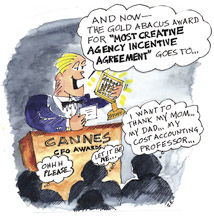|
Incentive compensation: A trend or a tsunami?
Some see bonuses tied to results in
three of four agency pay plans
By John Emmerling
Advertising Age
March 1, 1999
 The phone rang. Would I speak at an industry seminar on agency compensation trends? (Momentary pause: I wonder if the caller knows I’m a creative guy—not a chief financial officer?) Then, I answered: "Sure, be happy to." After all, the world of compensation is changing fast—with new options, new alternatives. No doubt, after some digging, I’d find a ton of innovative approaches. The phone rang. Would I speak at an industry seminar on agency compensation trends? (Momentary pause: I wonder if the caller knows I’m a creative guy—not a chief financial officer?) Then, I answered: "Sure, be happy to." After all, the world of compensation is changing fast—with new options, new alternatives. No doubt, after some digging, I’d find a ton of innovative approaches.
First, for a snapshot of the kind of compensation agreements that are out there, I got a copy of the "Trends in Agency Compensation" report, a survey conducted periodically for the Association of National Advertisers by Jones-Lundin Associates, Chicago. This survey, (with data from ’97), included responses from half of ANA’s membership. It revealed that commission compensation systems are dramatically eroding—only 35% of ANA agency contracts remain "billings-based."
MOST SIGNIFICANT TREND
As commission systems plummet, a new No. 1 is rising to top the compensation hit parade: 53% of ANA agreements are "labor-based" (i.e., fees based on hours expended).
The biggest news is this: 30% of the advertisers are using incentive compensation agreements. Tucked away in those ANA agency agreements are performance-based bonuses for achieving goals. That 30% incidence of advertisers using incentive compensation agreements was up 11 points from the 1994 survey.
Robert Lundin, president of Jones-Lundin, has called this trend more significant than the survey’s other trend data.
But the ANA data are 18-months old. What’s happening now? And how about a forecast for five years from now? Looking for some educated guesses, I reached for the phone.
MORE INCENTIVE-PAY PLANS
My telephone survey included 28 people—agency CEOs and chief financial officers, accountants, search consultants, and clients. I asked each respondent the same question—"Do you expect that, by 2004, more agency agreements will contain incentive components?" Twenty-seven people said "yes;" one holdout voted "about the same as today."
Peter Georgescu, CEO of Young & Rubicam, felt strongly about incentives, saying that clients need more than campaigns or consultants—they need partners.
"The best way to be a partner," Mr. Georgescu explained, "is to have the same set of objectives as your client—where the agency’s interest is aligned with the client’s."
And how many Y&R clients will be using incentives by 2004? Peter’s answer was a stunner: "Five years from today," he stated, "certainly 75% to 90% percent of our agreements will have incentive components."
NO ONE AT THE DOOR
Keith Reinhard, CEO of DDB Needham Worldwide (and the godfather of incentives) began agitating back in 1990 for what he termed "pay-for-results." What happened?
"People did not exactly line up at our door," he admitted. "There was a lot of pressure to retain the commission system even though it was moving from 15 to 13 to 11%."
But now that pay-for-results is finally becoming fashionable, what does Keith predict for 2004? What percent of DDB Needham client agreements are likely to contain an incentive component? "I’ll go with 75%," he told me.
These two agency figures are predicting that in five years, at least three-quarters of their client agreements will include incentives. That’s a huge increase over today’s 30% incentive-based agreements, as reported in the ANA study.
But what’s in this for clients? Why should they hand out bonuses?
There’s only one answer. By aligning their agencies’ interests with their own, clients are paying for superior results.
PAY LINKED TO TAP HANDLES
Example: Several years ago, research showed ad awareness for Anheuser-Busch’s Bud Light was flat and competitive images were weakening. DDB Needham’s client wanted to take advantage of regional opportunities and increase consumer, wholesaler, and retailer involvement. Most of all, it wanted to increase the Bud Light tap handles in the pubs.
So, an incentive was brewed up. The agency would get a bonus for helping to deliver significantly more tap handles.
The options were wide open. The company wasn’t asking for a new TV campaign or for a clever schedule of radio spots. It wanted tap handles.
Unconstrained by tradition, the agency tackled this challenge—and created an unexpected idea. They would offer beer drinkers the chance to star in a local Bud Light TV commercial.
The promotion rolled out with a trade competition. Wholesalers picked the best retailers in their regions, but to join the party, a bar needed Bud Light tap handles. Casting calls were announced. "You can star in a Bud Light commercial!" People mobbed the participating bars, auditioned for parts and drank mug after mug of brew.
How well did it work? According to Mr. Reinhard, it was "fantastic in terms of the number of new tap handles." And would the idea have happened under a standard compensation agreement? His answer: "Never!"
CREATIVITY FOR CFOS
That’s the key. Incentives can unleash and unfetter an agency’s creative thinking. The resulting marketing solutions can be breathtakingly original. Overall, client brands will be better served. It’s why General Motors, Ford and Procter & Gamble are now trying out incentive agreements. It’s why Sears, Kraft and Colgate were using them back in 1996.
As incentives continue to gather steam, we may witness the birth of "CFO Creativity." Innovative contracts will be needed. New ways to measure performance will be devised. And—who knows?—someday, there may even be a Cannes Festival award for "Best Incentive Agreement of the Year."
Keep your tux handy.
back to top | more columns »
|





